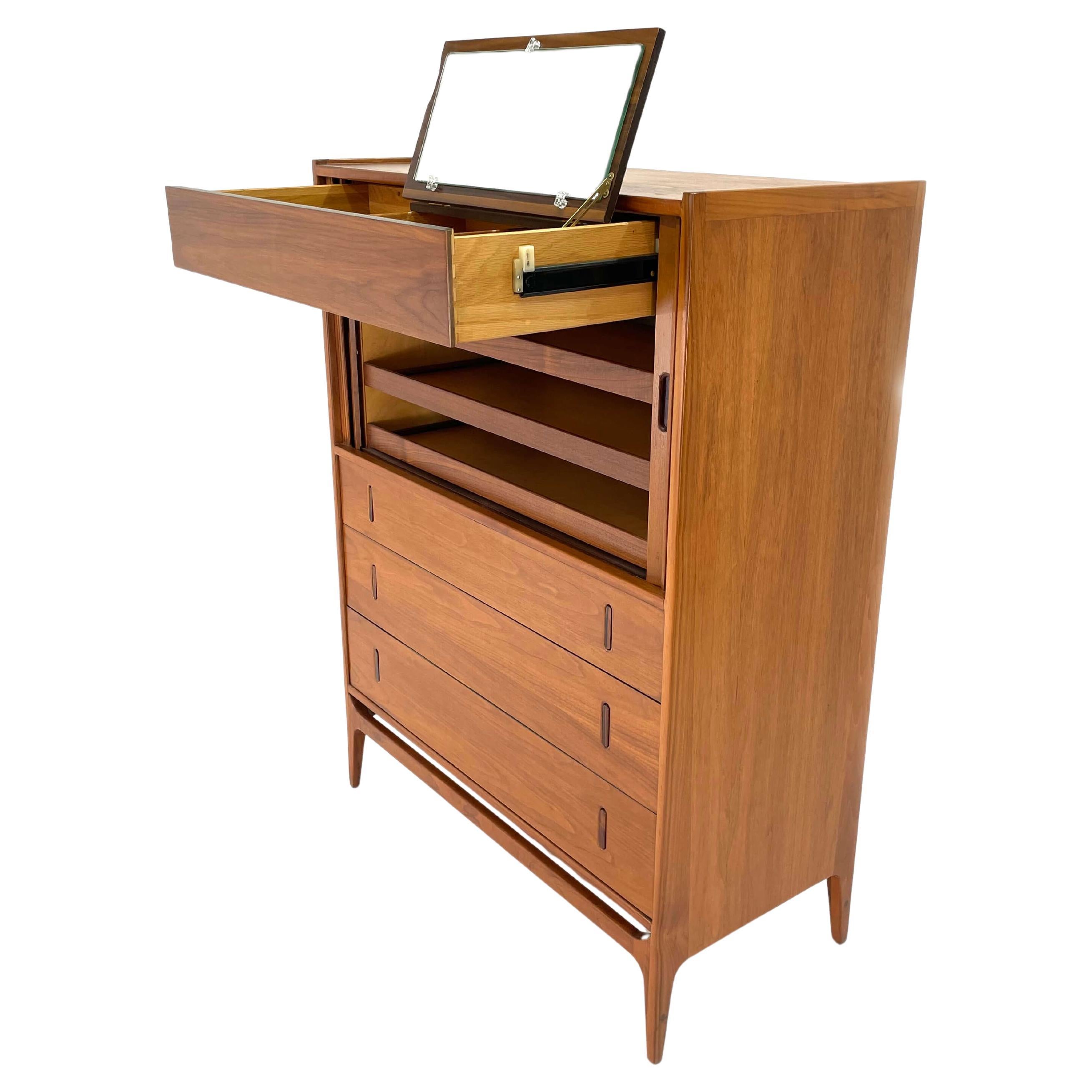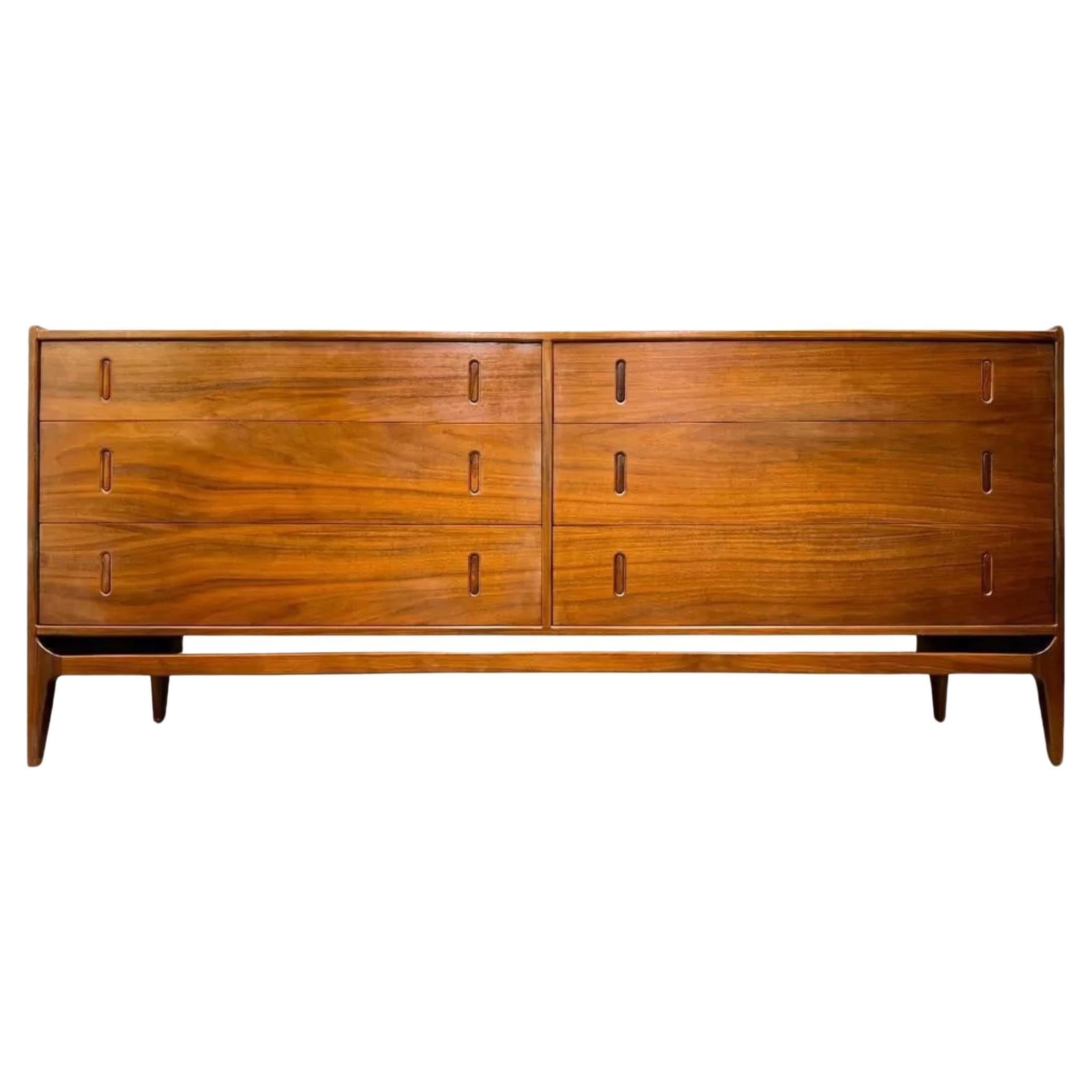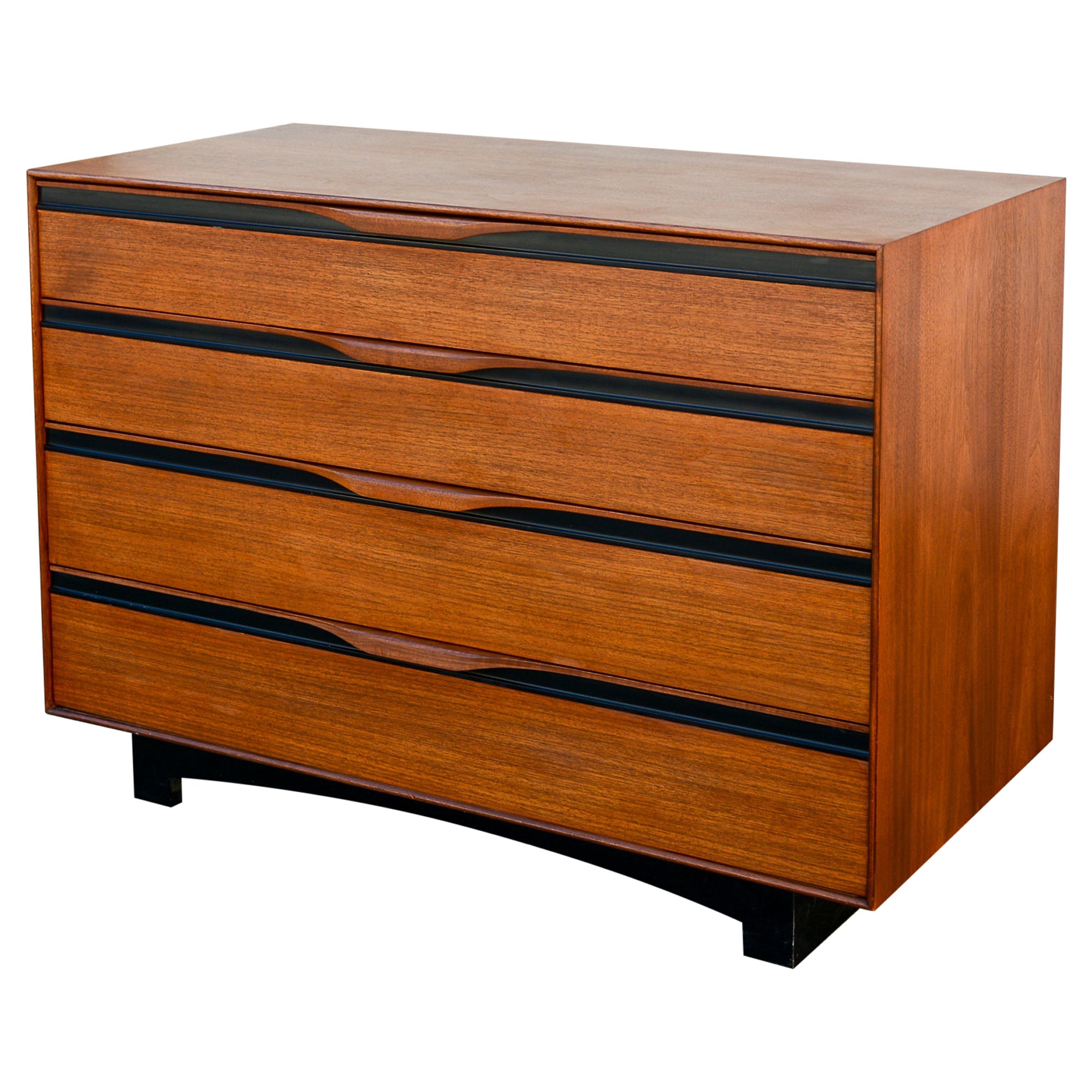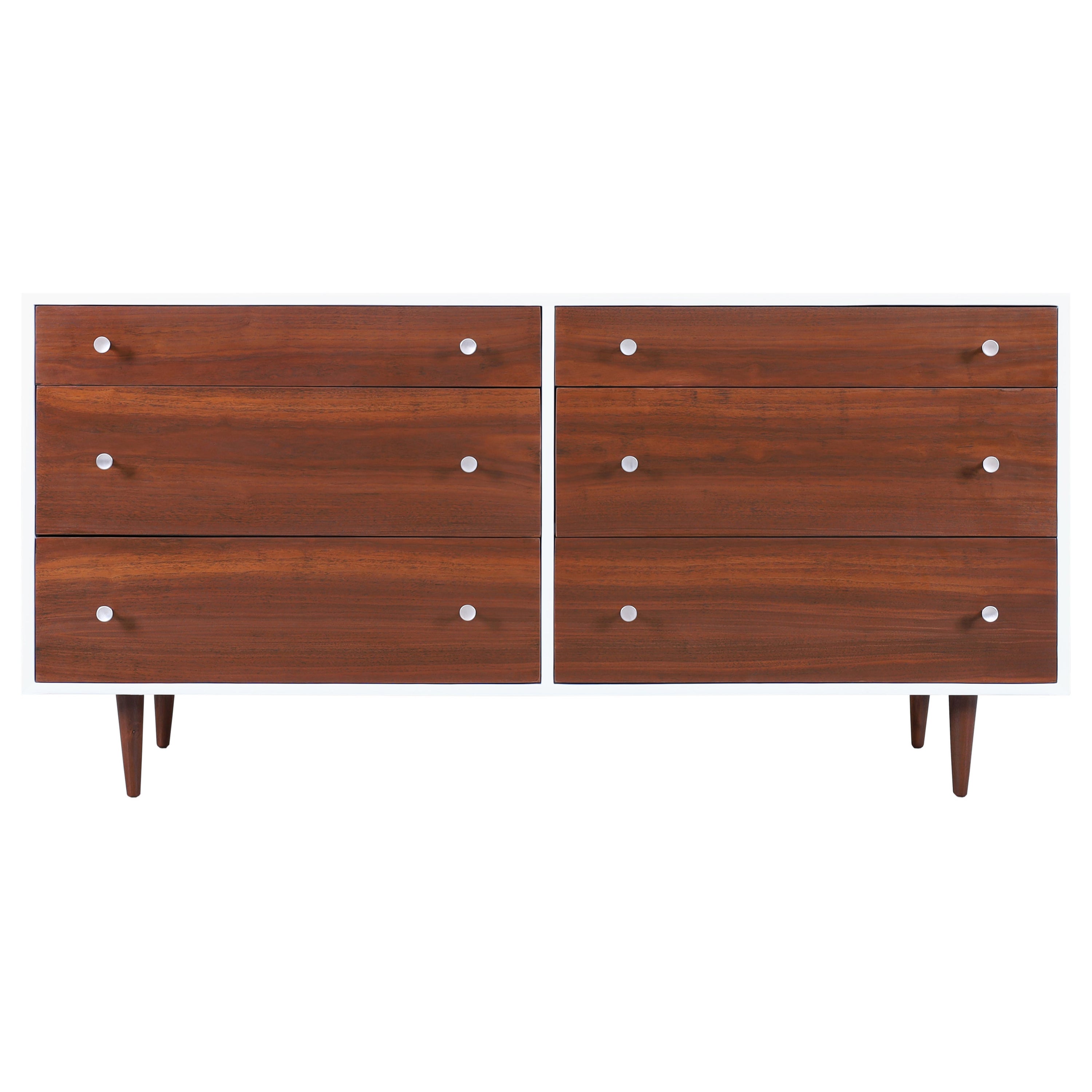Glenn of California Dresser by Richard Thompson
About the Item
- Creator:Richard Thompson (Designer),Glenn of California (Manufacturer)
- Dimensions:Height: 30.5 in (77.47 cm)Width: 71.5 in (181.61 cm)Depth: 18.25 in (46.36 cm)
- Style:Mid-Century Modern (Of the Period)
- Materials and Techniques:
- Place of Origin:
- Period:
- Date of Manufacture:circa 1950
- Condition:Refinished. Condition: Restored to very good vintage condition. Drawers slide smoothly. Structurally sound. The top has been restored but there are a few areas of vintage wear we could not remove. Small areas of discoloration. Overall presents very well.
- Seller Location:San Diego, CA
- Reference Number:1stDibs: LU6417237339342
Glenn of California
Credited for being at the forefront of the West Coast modernist design movement, Glenn of California introduced a relaxed, breezy and elegant style to postwar America. The company was based in Arcadia, California, a city situated near Los Angeles at the base of the San Gabriel Mountains. It specialized in the production of easily accessible and reasonably affordable furnishings that included credenzas, chairs, cabinets, tables and more.
However, it wasn’t until Glenn of California hired the prolific American furniture designer Milo Baughman that the company made a name for itself in the annals of American mid-century modern design. Baughman prioritized function — he worked with simple forms and often used sleek, flat-bar chromed metal and natural materials such as walnut in his pieces.
Glenn of California marketed Baughman’s designs along with those of unsung Swedish architect and designer Greta Magnusson Grossman in their successful California Modern collection. The first woman to receive an award from the Swedish Society of Industrial Design, Magnusson Grossman drew on her Scandinavian heritage to create iconic homes as well as furnishings for Glenn and other companies that helped define mid-century-era Southern California. The furniture she and Baughman designed became known for its laid-back Los Angeles style and thoughtful integration of walnut, iron and Formica.
In addition to employing the talents of Baughman and Magnusson Grossman, Glenn of California collaborated with several other notable and influential designers. These included Stanley Young, Kipp Stewart, John Kapel and Paul Laszlo. Laszlo, an American-Hungarian architect, interior designer and furniture designer, was well-regarded among Hollywood’s elite and designed pieces for Cary Grant, Barbara Stanwyck and Elizabeth Taylor.
While the company is no longer in business, vintage Glenn of California furniture remains highly sought-after by collectors and enthusiasts.
Discover a range of vintage Glenn of California dressers, dining tables, chairs and other furniture on 1stDibs.
- ShippingRetrieving quote...Ships From: San Diego, CA
- Return PolicyA return for this item may be initiated within 1 day of delivery.
- Glenn of California Gentleman's Dresser by Richard ThompsonBy Glenn of California, Richard ThompsonLocated in San Diego, CAGlenn of California dresser or gentleman's chest designed by Richard Thompson. The case is made of walnut and has retractable inlaid rosewood pulls. The walnut is a golden warm color...Category
Mid-20th Century American Mid-Century Modern Dressers
MaterialsRosewood, Walnut
- Greta Magnusson Grossman Dining Table for Glenn of CaliforniaBy Greta Magnusson Grossman, Glenn of CaliforniaLocated in San Diego, CARare Rectangular dining table by Greta M. Grossman for Glenn of California, circa. 1950s. The table features a solid walnut wood frame with a black laminate top and iron stretchers s...Category
Vintage 1950s American Mid-Century Modern Dining Room Tables
MaterialsLaminate, Walnut
- George Nelson Rosewood Thin Edge 4 drawer Dresser by Herman Miller #2By George NelsonLocated in San Diego, CAA rosewood thin edge chest designed by George Nelson for Herman Miller with exquisite rosewood grain and early original white porcelain handles. The George Nelson Rosewood Thin Edge 4-drawer Dresser, crafted by Herman Miller, epitomizes the timeless elegance and functional sophistication synonymous with mid-century modern design. This dresser stands as an iconic piece within the George Nelson collection, renowned for its clean lines, minimalist aesthetic, and impeccable craftsmanship. This particular example boasts exquisite rosewood grain and early original white porcelain handles. Constructed from rich rosewood veneer, the dresser boasts a warm, organic hue that exudes luxury and refinement. Its slender profile and thin edges create an illusion of lightness, enhancing the overall sense of modernity and grace. The 4 spacious drawers feature seamless integration of hardware, maintaining the dresser's sleek appearance while providing ample storage space for clothing, linens, or personal belongings. Each detail of the George Nelson Rosewood Thin Edge series reflects an unwavering commitment to both form and function. Its timeless design transcends trends, making it a versatile addition to any interior decor scheme, from minamalist to post-modern. Whether used in a bedroom, living area, or office space, this dresser elevates the ambiance with its understated elegance and unparalleled craftsmanship, showcasing the enduring legacy of George Nelson's visionary design ethos. About the Designer: Not everyone thinks of George Nelson when they think “Modernism”—but they should. Here’s why: Looking at the outset of George Nelson’s career, few would have guessed that his legacy would crown him as one of the most influential individuals in Modernism—story has it that the young Ivy Leaguer stumbled into the Yale School of Architecture seeking shelter from the rain, and only then did he consider studying design. His legacy, though, would be one that touched nearly every corner of American Modernism as we think of it today. As an architect, author, furniture designer, graphic designer, exhibition designer, teacher, amateur photographer, and general provocateur, George Nelson shaped the course of design in America for over four decades. After completing his two Bachelor’s degrees (one in architecture, the other in fine arts), Nelson went on to accept a traveling fellowship in Rome, which interfaced him with figures like Ludwig Mies Van Der Rohe, Walter Gropius, Le Corbusier, and Gio Ponti all of which he interviewed forPencil Point, bringing the European vanguard to the attention of the magazine’s American readership. At this point in his career, Nelson had devoted himself to writing, joining Architectural Forum as its first associate editor in 1935. For nearly a decade, Nelson’s post as an editor brought him face-to-face with many of the leaders of the Modernism movement in the U.S., and through these exchanges, his own stance in the design world began to solidify. For Nelson, the purpose of design was to improve the world in accordance with the laws of nature—and while he hadn’t yet done much designing himself, he was busy teasing out the theoretical details of architecture. In 1940, Nelson co-authored Tomorrow’s House with Henry Wright, and the book went on to be a great commercial success, introducing concepts like the “family room,” and more broadly assuming a solutions-based perspective for architectural design. It wasn’t long before the book earned him the favorable attention of D.J. Depree, the chairman of Herman Miller the American furniture manufacture. Despite Nelson’s inexperience in furniture design, Depree saw potential in the writer’s approach to the industry: solutions-oriented design with a practical lean. Nelson became the company’s Director of Design in 1947, under the condition that he be allowed to continue his work outside of the company. From 1947 to 1972, Nelson oversaw the design department at Herman Miller, bringing in the icons that would shape some of the most memorable pieces of mid-century design, from such people as Ray and Charles Eames and Harry Bertoia to Richard Schultz, Donald Knorr, and Isamu Noguchi. Beginning in the mid-1950s, Nelson’s own design firm began its work in earnest, producing furniture and pioneering a ubiquitous incorporation of design, bringing that same consideration for pragmatism and aesthetics to advertising and marketing materials, image management, and graphic programs. His own firm incorporated in 1955, tapping many of the same designers from the Herman Miller roster for collaborations under George Nelson Associates, Inc. It was during this period of Nelson’s life and career that many of his most iconic designs came onto the scene—many will be instantly familiar furniture silhouettes that perhaps you didn’t know sprung from George Nelson himself. Designing his first collection in 1945 and appointed design director in 1947, Nelson quickly expanded his purview and transformed the company. Confirming De Pree’s early assessment of Nelson as someone “thinking well ahead of the parade,” he redesigned everything from Herman Miller’s product line to its graphics and marketing and advertising materials. Over the course of his long association with Herman Miller, Nelson designed hundreds of pieces of furniture and recruited other designers, including Charles and Ray Eames, Alexander Girard, and Isamu Noguchi, now all widely acknowledged as some of the brightest talents of the time. Nelson developed his own designs—from furniture to architecture, and exhibitions to graphics—in his New York City studio, known variously over the years as George Nelson, George Nelson & Associates, and George Nelson and Company. The staff included significant designers in their own right such as Irving Harper, George Mulhauser, Ernest Farmer, Gordon Chadwick, George Tscherny...Category
Vintage 1950s American Mid-Century Modern Dressers
MaterialsAluminum
- George Nelson Rosewood Thin Edge 4 drawer Dresser by Herman Miller #1By George NelsonLocated in San Diego, CAA rosewood thin edge chest designed by George Nelson for Herman Miller with exquisite rosewood grain and early original white porcelain handles. The George Nelson Rosewood Thin Edge 4-drawer Dresser, crafted by Herman Miller, epitomizes the timeless elegance and functional sophistication synonymous with mid-century modern design. This dresser stands as an iconic piece within the George Nelson collection, renowned for its clean lines, minimalist aesthetic, and impeccable craftsmanship. This particular example boasts exquisite rosewood grain and early original white porcelain handles. Constructed from rich rosewood veneer, the dresser boasts a warm, organic hue that exudes luxury and refinement. Its slender profile and thin edges create an illusion of lightness, enhancing the overall sense of modernity and grace. The 4 spacious drawers feature seamless integration of hardware, maintaining the dresser's sleek appearance while providing ample storage space for clothing, linens, or personal belongings. Each detail of the George Nelson Rosewood Thin Edge series reflects an unwavering commitment to both form and function. Its timeless design transcends trends, making it a versatile addition to any interior decor scheme, from minamalist to post-modern. Whether used in a bedroom, living area, or office space, this dresser elevates the ambiance with its understated elegance and unparalleled craftsmanship, showcasing the enduring legacy of George Nelson's visionary design ethos. About the Designer: Not everyone thinks of George Nelson when they think “Modernism”—but they should. Here’s why: Looking at the outset of George Nelson’s career, few would have guessed that his legacy would crown him as one of the most influential individuals in Modernism—story has it that the young Ivy Leaguer stumbled into the Yale School of Architecture seeking shelter from the rain, and only then did he consider studying design. His legacy, though, would be one that touched nearly every corner of American Modernism as we think of it today. As an architect, author, furniture designer, graphic designer, exhibition designer, teacher, amateur photographer, and general provocateur, George Nelson shaped the course of design in America for over four decades. After completing his two Bachelor’s degrees (one in architecture, the other in fine arts), Nelson went on to accept a traveling fellowship in Rome, which interfaced him with figures like Ludwig Mies Van Der Rohe, Walter Gropius, Le Corbusier, and Gio Ponti all of which he interviewed forPencil Point, bringing the European vanguard to the attention of the magazine’s American readership. At this point in his career, Nelson had devoted himself to writing, joining Architectural Forum as its first associate editor in 1935. For nearly a decade, Nelson’s post as an editor brought him face-to-face with many of the leaders of the Modernism movement in the U.S., and through these exchanges, his own stance in the design world began to solidify. For Nelson, the purpose of design was to improve the world in accordance with the laws of nature—and while he hadn’t yet done much designing himself, he was busy teasing out the theoretical details of architecture. In 1940, Nelson co-authored Tomorrow’s House with Henry Wright, and the book went on to be a great commercial success, introducing concepts like the “family room,” and more broadly assuming a solutions-based perspective for architectural design. It wasn’t long before the book earned him the favorable attention of D.J. Depree, the chairman of Herman Miller the American furniture manufacture. Despite Nelson’s inexperience in furniture design, Depree saw potential in the writer’s approach to the industry: solutions-oriented design with a practical lean. Nelson became the company’s Director of Design in 1947, under the condition that he be allowed to continue his work outside of the company. From 1947 to 1972, Nelson oversaw the design department at Herman Miller, bringing in the icons that would shape some of the most memorable pieces of mid-century design, from such people as Ray and Charles Eames and Harry Bertoia to Richard Schultz, Donald Knorr, and Isamu Noguchi. Beginning in the mid-1950s, Nelson’s own design firm began its work in earnest, producing furniture and pioneering a ubiquitous incorporation of design, bringing that same consideration for pragmatism and aesthetics to advertising and marketing materials, image management, and graphic programs. His own firm incorporated in 1955, tapping many of the same designers from the Herman Miller roster for collaborations under George Nelson Associates, Inc. It was during this period of Nelson’s life and career that many of his most iconic designs came onto the scene—many will be instantly familiar furniture silhouettes that perhaps you didn’t know sprung from George Nelson himself. Designing his first collection in 1945 and appointed design director in 1947, Nelson quickly expanded his purview and transformed the company. Confirming De Pree’s early assessment of Nelson as someone “thinking well ahead of the parade,” he redesigned everything from Herman Miller’s product line to its graphics and marketing and advertising materials. Over the course of his long association with Herman Miller, Nelson designed hundreds of pieces of furniture and recruited other designers, including Charles and Ray Eames, Alexander Girard, and Isamu Noguchi, now all widely acknowledged as some of the brightest talents of the time. Nelson developed his own designs—from furniture to architecture, and exhibitions to graphics—in his New York City studio, known variously over the years as George Nelson, George Nelson & Associates, and George Nelson and Company. The staff included significant designers in their own right such as Irving Harper, George Mulhauser, Ernest Farmer, Gordon Chadwick, George Tscherny...Category
Vintage 1950s American Mid-Century Modern Dressers
MaterialsAluminum
- Arne Vodder Triennale 4 Drawer Dresser by Sibast (2 available)By Arne Vodder, SibastLocated in San Diego, CAAn iconic design by Arne Vodder Triennale 4-drawer dresser was produced by Sibast Mobler, circa 1950. Constructed in teak, the 4-drawer dresser i...Category
Vintage 1950s Danish Scandinavian Modern Dressers
MaterialsTeak
- George Nakashima "Origins' Walnut Dresser for WiddicombBy George Nakashima, Widdicomb Furniture Co.Located in San Diego, CAA very rare and exceptional mid-century Organic Modern monumental triple dresser. The Origins Group was created by George Nakashima, widely considered one of the world's greatest ...Category
Mid-20th Century American Mid-Century Modern Dressers
MaterialsBrass
- Richard Thompson Stereo Cabinet or Bar by Glenn of CaliforniaBy Richard Thompson, Glenn of CaliforniaLocated in Highland, INDesigned by Richard Thompson for Glenn of California, this walnut cabinet has four doors which conceal an upper and lower cabinet. The upper cabinet is fitted with a vintage McIntosh mac 4100 stereo receiver/ amplifier, an ADS compact disk player, and a dual 1219 turntable. The lower cabinet houses a Sony 400 disk CD player...Category
Vintage 1960s American Mid-Century Modern Cabinets
MaterialsWalnut
- Mid Century Modern long low Walnut 6 Drawer Dresser designed by Richard ThompsonBy Glenn of California, Richard ThompsonLocated in BROOKLYN, NYMid Century Modern long low Walnut 6 Drawer Dresser designed by Richard Thompson for Glenn of California. Walnut case with flush pop out rosewood pulls. Drawers slide smoothly. Struc...Category
Vintage 1960s American Mid-Century Modern Dressers
MaterialsRosewood, Walnut
- Large Walnut Dresser by John Kapel for Glenn of CaliforniaBy John Kapel, Glenn of CaliforniaLocated in East Hampton, NYThis is an excellent long version of John Kapel's iconic dresser by Glenn of California in walnut and black trim. Eight ample drawers and the drawers slide easily.Category
Vintage 1960s Mid-Century Modern Dressers
MaterialsWalnut
- Small Walnut Dresser by John Kapel for Glenn of CaliforniaBy Glenn of California, John KapelLocated in San Mateo, CASmall four drawer chest designed by John Kapel for Glenn of California. The chest is walnut with a black laminate base and black plastic strips below the drawer pulls. The drawers op...Category
Mid-20th Century American Mid-Century Modern Dressers
MaterialsPlastic, Walnut
- Glenn of California Walnut and Lacquered Dresser by Milo BaughmanBy Glenn of California, Milo BaughmanLocated in North Hollywood, CABeautiful vintage two-tone dresser designed by the iconic designer Milo Baughman for Glenn of California in the United States, circa 1950s. This dresser has a minimalist design that ...Category
Vintage 1950s American Mid-Century Modern Dressers
MaterialsStainless Steel
- 1960's Mid-Century Modern Glenn of California Highboy DresserBy Glenn of California, Greta Magnusson Grossman, Kipp StewartLocated in Burbank, CAVintage Midcentury Modern dresser for sale. Manufactured in the 1960's by Glenn of California, and has been professionally refinished. It's made of walnut, and has four solid walnut ...Category
Vintage 1960s American Mid-Century Modern Dressers
MaterialsAluminum






